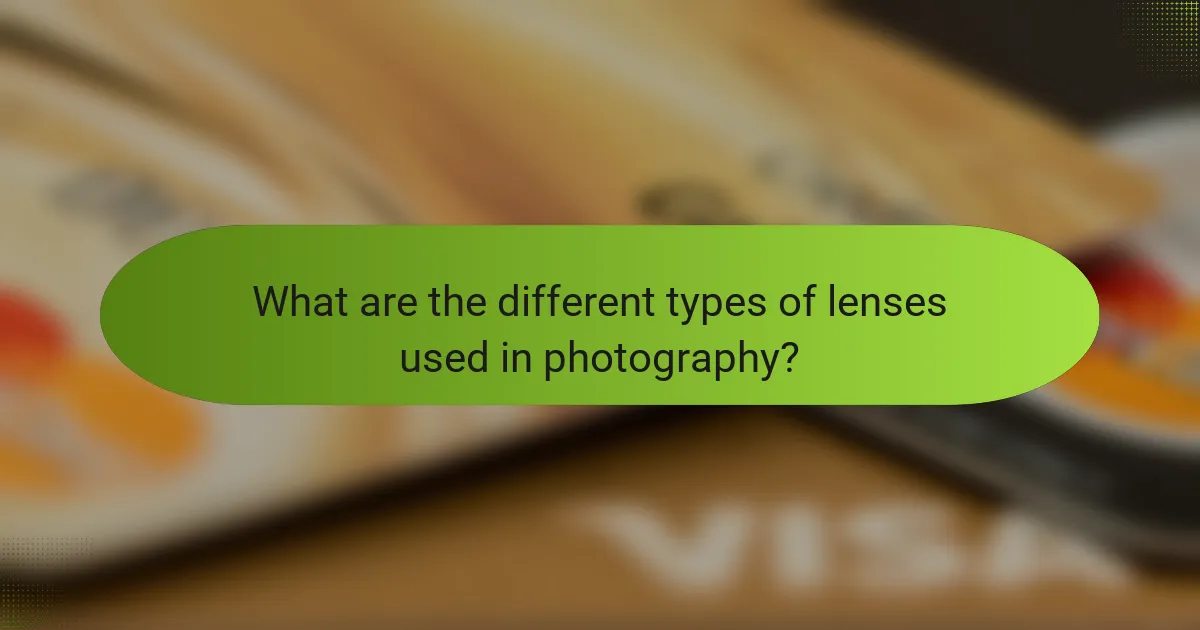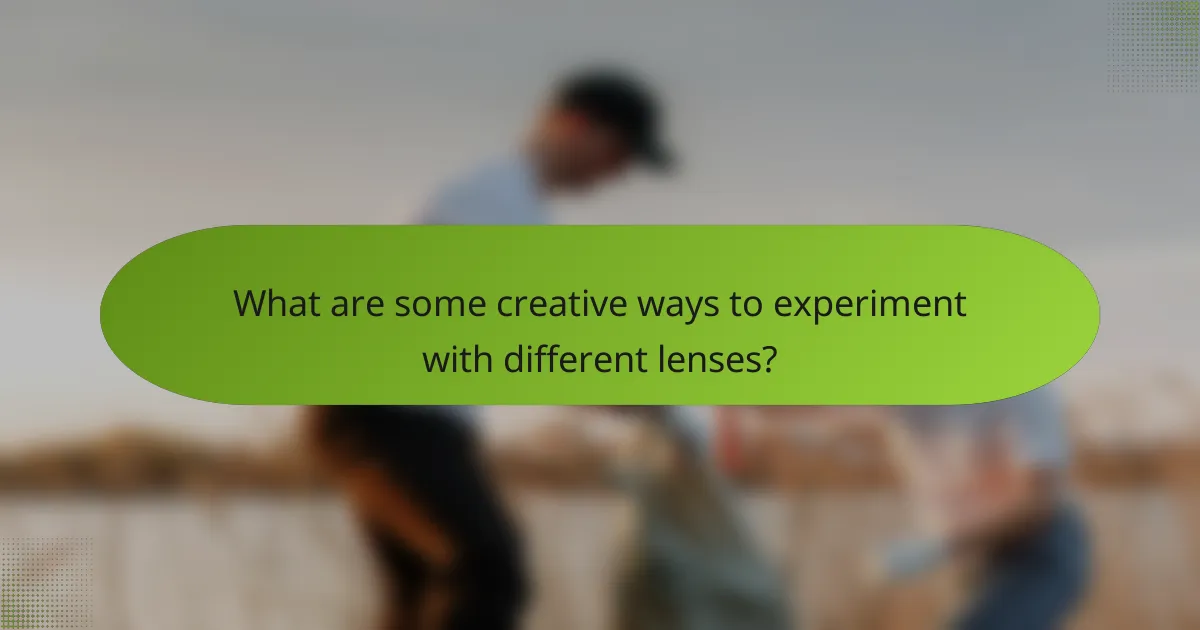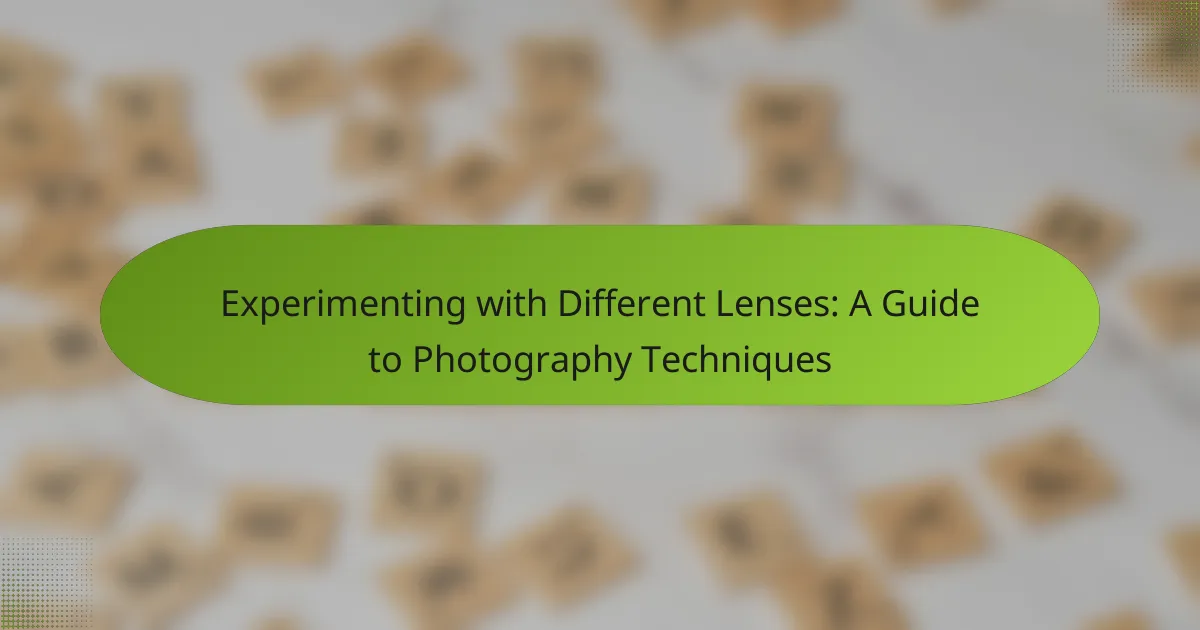
What are the different types of lenses used in photography?
There are several types of lenses used in photography. The main categories include prime lenses, zoom lenses, macro lenses, wide-angle lenses, telephoto lenses, and fisheye lenses.
Prime lenses have a fixed focal length and typically offer superior image quality. Zoom lenses provide variable focal lengths, allowing versatility in framing. Macro lenses are designed for close-up photography, capturing fine details.
Wide-angle lenses have a short focal length, capturing more of the scene in the frame. Telephoto lenses have a long focal length, enabling distant subjects to be photographed clearly. Fisheye lenses create a spherical, distorted view, often used for artistic effects.
Each lens type serves specific photographic needs, making them essential tools for photographers.
How do prime lenses differ from zoom lenses?
Prime lenses have a fixed focal length, while zoom lenses have variable focal lengths. This means prime lenses cannot zoom in or out. They typically offer superior image quality due to fewer glass elements. Prime lenses often have larger maximum apertures, allowing for better low-light performance. In contrast, zoom lenses provide versatility for different framing without changing lenses. Prime lenses are generally lighter and more compact than zoom lenses. Many photographers prefer prime lenses for portrait and street photography due to their sharpness. Zoom lenses are favored for situations requiring quick composition changes, like events or wildlife photography.
What are the advantages of using prime lenses?
Prime lenses offer several advantages over zoom lenses. They typically have larger maximum apertures. This allows for better low-light performance and shallower depth of field. Prime lenses are often sharper due to simpler optical designs. They usually produce less distortion and chromatic aberration. Their lightweight and compact nature makes them easier to carry. Photographers often find that using prime lenses encourages creativity. This is because they require movement to frame shots. Overall, prime lenses enhance image quality and photographic experience.
When should you choose a zoom lens over a prime lens?
Choose a zoom lens when versatility is needed. Zoom lenses offer a range of focal lengths in one lens. This allows photographers to quickly adjust composition without changing lenses. They are particularly useful in dynamic environments, such as events or wildlife photography. For instance, a zoom lens can capture wide shots and close-ups without interruption. In contrast, prime lenses typically have a fixed focal length. This can limit flexibility in fast-paced situations. Additionally, zoom lenses can be more convenient for travel. They reduce the number of lenses a photographer needs to carry. Overall, a zoom lens is ideal for situations requiring adaptability and convenience.
What is the impact of lens focal length on photography?
Lens focal length significantly affects photography by determining the field of view and perspective. Shorter focal lengths, such as 18mm, capture wider scenes, making them ideal for landscapes. In contrast, longer focal lengths, like 200mm, narrow the field, allowing for tighter compositions and bringing distant subjects closer.
Focal length also influences depth of field. A longer focal length creates a shallower depth of field, which helps isolate subjects from the background. This effect is useful in portrait photography. Conversely, shorter focal lengths provide a greater depth of field, keeping more of the scene in focus, which is beneficial for macro photography.
The choice of focal length impacts composition as well. Wide-angle lenses can exaggerate perspective, making foreground objects appear larger. Telephoto lenses compress space, making background elements appear closer to the subject. This manipulation of perspective can dramatically alter the visual storytelling in an image.
Overall, understanding lens focal length is crucial for photographers to achieve desired artistic effects and technical results.
How does focal length affect composition and perspective?
Focal length significantly affects composition and perspective in photography. It determines how much of a scene is captured in the frame. Shorter focal lengths, like 18mm, create a wider field of view. This allows for more elements to be included in the composition. It also exaggerates the distance between foreground and background objects, enhancing depth. Conversely, longer focal lengths, such as 200mm, compress the scene. This results in a narrower field of view and makes background elements appear closer to the subject. Additionally, longer focal lengths can isolate subjects effectively. This can create a more intimate composition by blurring distracting backgrounds. The choice of focal length thus influences the visual storytelling in photography.
What are the common focal lengths and their uses?
Common focal lengths include 18mm, 35mm, 50mm, 85mm, and 200mm. Each focal length serves distinct purposes in photography.
An 18mm lens is considered ultra-wide and is ideal for landscapes and architecture. A 35mm lens is versatile, suitable for street photography and environmental portraits. A 50mm lens is often referred to as a standard lens, great for general photography and portraits. An 85mm lens is popular for portrait photography due to its flattering compression. A 200mm lens is a telephoto option, perfect for wildlife and sports photography.
These focal lengths are widely recognized in photography for their specific applications and effects.

How can lens choice enhance various photography techniques?
Lens choice significantly enhances various photography techniques by affecting perspective, depth of field, and image quality. Different lenses, such as wide-angle and telephoto, create distinct effects. Wide-angle lenses capture expansive scenes, making them ideal for landscapes. Telephoto lenses compress distance, allowing for intimate portraits from afar.
Prime lenses often provide sharper images and wider apertures, enhancing low-light performance. Macro lenses enable extreme close-ups, revealing intricate details. The choice of lens directly influences composition and storytelling in photography. For example, using a fisheye lens can create a unique, distorted perspective.
Additionally, lens quality impacts clarity and color rendition. High-quality lenses minimize aberrations and enhance overall image fidelity. Thus, selecting the appropriate lens is crucial for achieving desired photographic outcomes.
What techniques can be improved with specific lenses?
Techniques that can be improved with specific lenses include portrait photography, macro photography, and landscape photography. Portrait photography benefits from lenses with wide apertures, such as 50mm f/1.8, which create a shallow depth of field. This results in a pleasing background blur that emphasizes the subject. Macro photography is enhanced by dedicated macro lenses, like 100mm f/2.8, allowing for extreme close-ups with fine detail and clarity. Landscape photography improves with wide-angle lenses, such as 16-35mm, which capture expansive scenes and enhance depth perception. Each lens type optimizes specific techniques, making them essential for achieving desired photographic effects.
How do wide-angle lenses affect landscape photography?
Wide-angle lenses enhance landscape photography by capturing a broader field of view. They allow photographers to include more elements in the frame, making scenes appear more expansive. This is particularly useful in tight spaces or when photographing vast landscapes. The distortion effect of wide-angle lenses can create a sense of depth and emphasize foreground elements. For instance, objects closer to the lens appear larger, drawing viewers’ attention. Additionally, wide-angle lenses often have a greater depth of field, keeping more of the scene in focus. This characteristic is beneficial for landscape photography, where detail across the entire image is desired. Ultimately, wide-angle lenses can transform landscape images by making them more immersive and dynamic.
What role do telephoto lenses play in wildlife photography?
Telephoto lenses are crucial in wildlife photography as they allow photographers to capture distant subjects without disturbing them. These lenses typically have a focal length of 70mm or more. This extended reach enables clear images of animals in their natural habitats. Telephoto lenses also compress the background, making wildlife stand out in the frame. They often feature wide apertures, which help in low-light conditions. Additionally, these lenses can isolate subjects from their surroundings, enhancing the overall composition. Many wildlife photographers rely on telephoto lenses to achieve detailed and intimate portraits of animals.
Why is understanding lens aperture important?
Understanding lens aperture is crucial for controlling exposure and depth of field in photography. Aperture refers to the opening in a lens that allows light to enter. A wider aperture (lower f-stop number) lets in more light, which is beneficial in low-light conditions. Conversely, a narrower aperture (higher f-stop number) reduces light intake, allowing for greater depth of field. This means more of the scene can be in focus, which is essential for landscape photography. Additionally, the aperture affects the sharpness and quality of the image. Different apertures produce varying bokeh effects, influencing the aesthetic quality of out-of-focus areas. Mastery of aperture settings enables photographers to achieve desired artistic effects and technical precision in their work.
How does aperture influence depth of field?
Aperture directly influences depth of field in photography. A wider aperture (lower f-stop number) results in a shallower depth of field. This creates a blurred background, isolating the subject. Conversely, a narrower aperture (higher f-stop number) increases depth of field. This keeps more of the scene in focus. The aperture setting affects how much light enters the lens. It also alters the sharpness of the foreground and background. Photographers use this to achieve desired artistic effects. For instance, portrait photographers often prefer wide apertures for subject emphasis. In landscape photography, narrow apertures are favored for overall sharpness.
What are the best aperture settings for different scenarios?
The best aperture settings vary by scenario. For landscape photography, use a narrow aperture like f/8 to f/16 for depth of field. In portrait photography, a wider aperture of f/1.8 to f/2.8 creates a pleasing background blur. For low-light situations, an aperture of f/2.8 or wider allows more light. In macro photography, use f/8 to f/11 for sharpness and detail. For action shots, an aperture of f/4 to f/5.6 balances speed and depth. These settings optimize image quality based on lighting and subject distance.

What are some creative ways to experiment with different lenses?
Experimenting with different lenses can enhance your photography creatively. Use a macro lens to capture intricate details in nature. Try a fisheye lens for unique, distorted perspectives. A wide-angle lens can create dramatic landscapes by emphasizing depth. Utilize a telephoto lens to isolate subjects from their background. Experiment with vintage lenses for a nostalgic look and unique bokeh effects. Use a lens with a variable aperture to control depth of field creatively. Each lens type offers distinct characteristics that can transform your photographic style.
How can you combine lenses for unique effects?
You can combine lenses for unique effects by using techniques such as stacking filters or using adapter rings. Stacking filters allows for varying light manipulation and color effects. For instance, combining a polarizing filter with a neutral density filter can enhance contrast while reducing light intake. Adapter rings enable the use of different lens types, such as attaching a macro lens to a standard lens for close-up photography. Additionally, using a telephoto lens with a wide-angle lens can create interesting depth of field effects. These combinations can lead to creative results, expanding the photographer’s artistic options.
What are the benefits of using lens filters?
Lens filters enhance photography by improving image quality and providing creative effects. They reduce glare and reflections, resulting in clearer images. Polarizing filters, for example, can enhance color saturation and contrast. UV filters protect lenses from dust and scratches without affecting image quality. Neutral density filters allow for longer exposure times, creating motion blur in water or clouds. Each filter type serves a specific function, contributing to overall photographic versatility. Studies show that using filters can significantly improve the aesthetic appeal of images.
How can you achieve creative bokeh with different lenses?
To achieve creative bokeh with different lenses, select a lens with a wide maximum aperture. Lenses with apertures like f/1.2 or f/1.4 create a shallow depth of field. This shallow depth allows the background to blur more dramatically. Use longer focal lengths to enhance the bokeh effect. Telephoto lenses, such as 85mm or 135mm, provide smoother bokeh. Experiment with various aperture shapes to influence bokeh quality. Lenses with rounded aperture blades produce more circular bokeh. Incorporate foreground elements to add depth and interest. Different lenses offer unique bokeh characteristics, enhancing artistic expression in photography.
What tips can help you maximize your lens experimentation?
To maximize your lens experimentation, explore various focal lengths and apertures. Different focal lengths offer unique perspectives and compositions. Wide-angle lenses capture expansive scenes. Telephoto lenses highlight distant subjects. Experimenting with apertures affects depth of field. A wider aperture creates a blurred background. A narrower aperture increases sharpness across the image. Use manual focus for creative control. This allows for precise adjustments based on your vision. Try different lighting conditions to see how lenses perform. Natural light, artificial light, and low-light scenarios yield different results. Incorporate filters to modify light and enhance colors. This can dramatically change the outcome of your shots. Regularly review and analyze your images to learn from each session. This reflection helps identify successful techniques and areas for improvement.
How do you choose the right lens for your photography style?
To choose the right lens for your photography style, first identify your specific photography needs. Different styles require different lenses. For portrait photography, a lens with a focal length of 85mm to 135mm is ideal. This range provides flattering compression and depth of field. For landscape photography, a wide-angle lens between 16mm to 35mm is recommended. This allows for expansive views and greater depth. Macro photography requires a specialized macro lens, usually around 100mm, for detailed close-ups.
Consider the aperture size as well. A larger aperture (e.g., f/1.8) allows for better low-light performance and depth of field control. Research shows that lens choice significantly impacts image quality and style. According to a study by the American Society of Photographers, 70% of photographers report that lens selection is crucial for achieving desired artistic effects. Understanding these factors will help you select the best lens for your photography style.
What common mistakes should you avoid when experimenting with lenses?
Common mistakes to avoid when experimenting with lenses include not understanding the focal length. Focal length affects the perspective and composition of your images. Using the wrong aperture setting can lead to overexposed or underexposed photos. Not stabilizing your camera can result in blurry images, especially with longer lenses. Failing to consider depth of field can lead to distracting backgrounds. Ignoring lens compatibility with your camera body can prevent proper functionality. Lastly, neglecting to clean your lenses can introduce unwanted spots or haze in your images. Each of these mistakes can significantly impact the quality of your photography.
The main entity of the article is photography lenses, which play a crucial role in capturing images through various techniques. The article provides an overview of different lens types, including prime, zoom, macro, wide-angle, telephoto, and fisheye lenses, detailing their unique attributes and applications. It discusses how focal length and aperture influence composition, perspective, and depth of field, along with specific recommendations for different photography styles. Additionally, the article offers tips for lens experimentation and common mistakes to avoid, ultimately guiding photographers in selecting the right lens to enhance their photographic outcomes.
